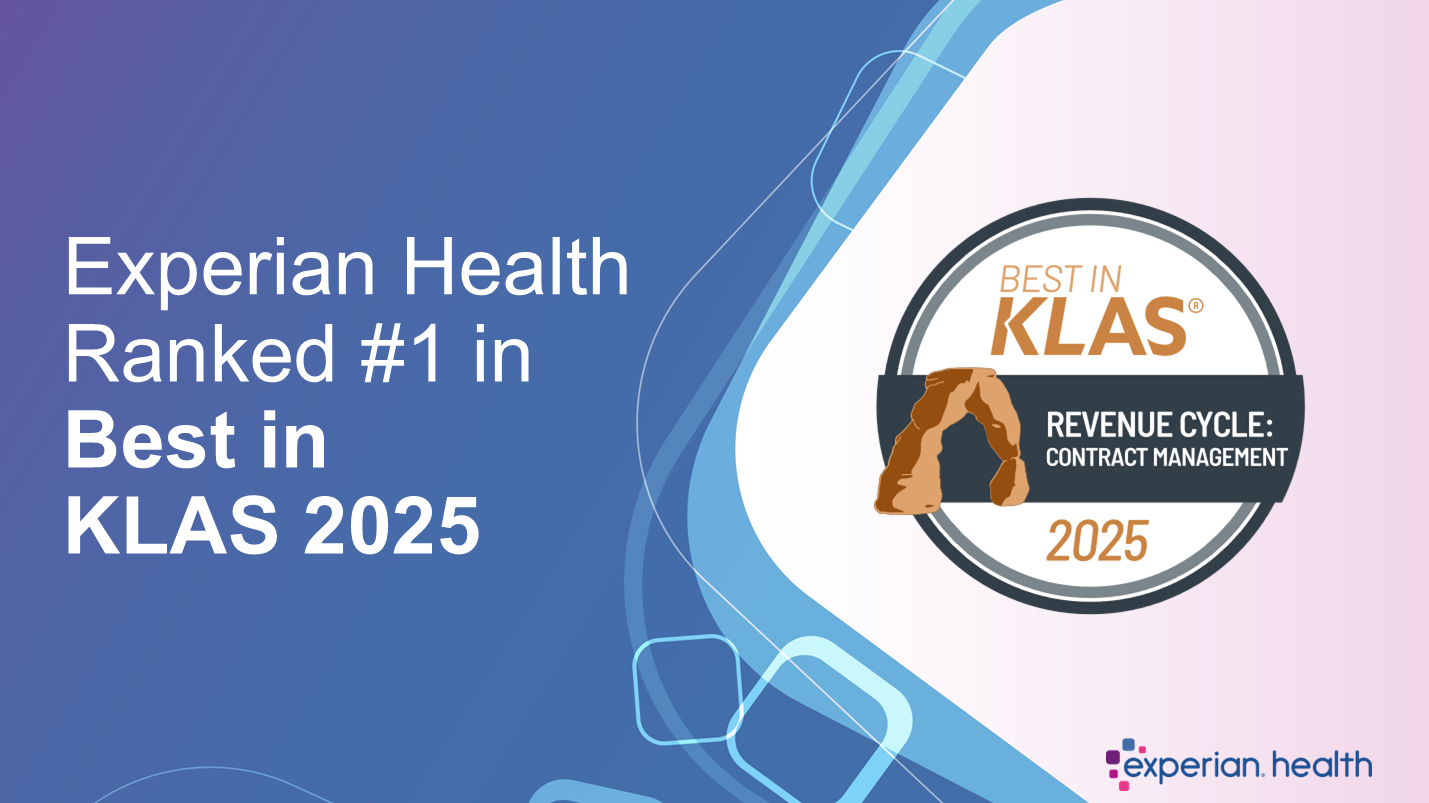Claims & Contract Management
Improve financial performance with automated, clean and data-driven medical claims management.

Early diagnostics, remote patient monitoring and personalized care recommendations are just a few examples of how artificial intelligence (AI) is transforming the way healthcare is delivered. As technology advances, so do opportunities to optimize clinical and operational processes. With projected savings in the region of up to $360 billion annually, it's no surprise that 75% of healthcare executives believe AI has reached a turning point in their industry. Yet many providers are still just scratching the surface. Only a small percentage use AI for complex tasks like claim denial management, leaving the competitive advantage wide open. Understanding how these technologies work – and where to apply them for maximum impact – will be crucial to improve efficiency, remain competitive and above all, deliver excellent patient care. The power of AI in healthcare As the name suggests, artificial intelligence refers to a machine's ability to perform cognitive tasks that would normally be associated with humans, such as problem-solving and decision-making. It can spot patterns, learn from experience and choose the right course of action to achieve a goal. Natural language processing, robotics and machine learning might all be in the mix. AI in the healthcare industry has been found to support applications like: Improving diagnosis through the analysis of medical images AI-powered wearables and virtual nursing assistants Patient data management Reducing and preventing insurance claim denials. Artificial intelligence in healthcare isn't a substitute for human contact, which underpins the best patient care. However, by increasing accuracy and reducing costs, it can help clinicians and healthcare administrators make better decisions that support a positive patient experience across virtually all healthcare settings. AI & automation in healthcare: key benefits AI and automation deliver results in the three areas that matter most to healthcare organizations: improving the patient experience and care delivery, allowing staff to perform at their highest level, and increasing revenue. Boosting patient satisfaction through speed and accuracy Patient feedback has a few common themes: timely access to care, clearer communication and greater financial transparency. To meet these needs (and improve those feedback scores), healthcare providers should offer patients accurate, upfront information and reduce friction wherever possible. Tools like Patient Access Curator use AI to verify and update all necessary patient information at the front end, all at once, which drastically reduces the time and effort required to manage patient records. This streamlines patient intake and solves for bad data, which prevents claim denials and increases patient satisfaction. Bringing in more revenue by reducing claims errors The 2024 CAQH index estimates that 22% of current costs could be saved by shifting from manual revenue cycle processes to automated ones. Experian Health's State of Claims Survey 2024 suggests providers are eager to capitalize on this opportunity, with 51% seeking to reduce manual work. AI-driven solutions like Patient Access Curator and AI Advantage are designed specifically to meet these needs. Patient Access Curator automates insurance eligibility and coverage, scanning patient documentation for inaccurate information, and uses AI and robotic process automation to reduce manual errors. AI Advantage™ works to prevent denials before they happen, using predictive analytics to flag claims errors and alert staff to claims that fail to meet payer requirements. Improving staff performance by easing burnout The strain of manual processes doesn't just slow down operations. It's also a major cause of staff stress and burnout. Around half of healthcare staff report feeling burned out, costing the industry an estimated $4.6 billion each year. By taking repetitive tasks off busy employees' plates, AI can alleviate overwork and allow staff to focus on higher-value work, improving job satisfaction and productivity. In claims management, for example, AI Advantage, works in conjunction with ClaimSource®, to proactively identify claims with a high likelihood of denial prior to claim submission without staff intervention. This reduces the burden on staff while improving clean claim rates. How AI Advantage and Patient Access Curator improve patient care Experian Health's two flagship AI-based products go even further, offering new ways to use technology to improve patient care: Patient Access Curator uses AI and robotic process automation to streamline one of the most tedious parts of patient intake – verifying insurance eligibility and coverage. By automatically scanning patient records for errors and pulling up-to-date information from payer sources, it eliminates the guesswork and manual labor that bog down revenue cycle teams. The result is faster, more accurate eligibility verification and a smoother experience for both staff and patients. As Ken Kubisty, VP of Revenue Cycle at Exact Sciences, put it: “Within the first six months of implementing the Patient Access Curator, we added almost 15% in revenue per test because we were now getting eligibility correct and being able to do it very rapidly.” On the back end, AI Advantage – Predictive Denials acts as an early warning system for denials, scanning claims before they go out the door to catch errors and flag risky submissions so they can be corrected in time. Built on advanced AI and machine learning, the platform evaluates claims using historical payment data and real-time payer behavior. Its counterpart, AI Advantage – Denial Triage, picks up where Predictive Denials leaves off, sorting rejected claims according to their potential for reimbursement and prioritizing them based on financial impact. Together, they help providers minimize denials, resulting in faster reimbursement and freeing up resources that can be redirected to patient care. Case study: See how AI Advantage helped Schneck Medical Center achieve a 4.6% average monthly decrease in denials in the first six months. The future of AI in healthcare: what's next? As a quick glance at any newsfeed will confirm, AI's role in healthcare is only going to expand. Predictive analytics will give staff increasingly powerful insights and recommendations to maximize reimbursements, while minimizing the burden on the workforce. AI's ability to continually learn and improve means providers that embrace AI will be better placed to make full use of their data and adapt to the trends and challenges that affect patient care. As expectations grow and resources shrink, AI is likely to be the only way to deliver the scalable, responsive, high-quality care patients deserve. Discover how solutions like AI Advantage and Patient Access Curator use artificial intelligence in healthcare to help reduce claim denials, improve patient access and more. AI Advantage Patient Access Curator

Experian Health's State of Claims survey finds that for many providers, it's getting harder to submit clean claims and taking longer to get paid. More than half say their current technology can't keep up. With revenue at risk, choosing the right denial management software is increasingly important. What features should healthcare organizations look out for to prevent denials and improve financial performance? Why denial management software is essential 11% of respondents in the State of Claims survey said that claims are denied more than 15% of the time, while the administrative cost of submitting and reworking claims continues to rise. Revenue cycle leaders are all too familiar with the challenges driving the denials trend: Frequent updates to payer policies, which make it harder for staff to be sure their submissions comply with the latest rules Incomplete or inaccurate data, such as missing codes or demographic errors, Staffing shortages put pressure on overworked teams, leading to higher error rates and slower response times Reimbursement delays, which tie up revenue and increase the cost of follow-up. Managing these issues is time-consuming and expensive. Speaking to the AAPC, Clarissa Riggins, Chief Product Officer at Experian Health, says that without a robust denial management strategy, providers risk falling further behind. “This growing crisis is a sign that traditional approaches are no longer enough, and providers should adopt more proactive strategies and the latest technology,” she says. Denial management software can help. By automating error detection, tracking payer requirements and helping staff prioritize high-risk claims, it can reduce denials and strengthen overall revenue cycle performance. According to the CAQH, just switching from manual to digital claim submission could save the industry up to $2.5 billion annually. Artificial intelligence (AI) and machine learning, used in solutions like AI Advantage™, can take those savings even further. Key features to look for in denial management software To make a real impact, healthcare denial management software must do more than just track denials. The best solutions offer faster responses, deeper insights and greater efficiency across the revenue cycle. Here are a few core features to seek out: Real-time claim monitoring Does the software alert users the instant a claim is denied? Real-time claim status updates are critical for minimizing delays and missed follow-ups. Automated alerts allow teams to act immediately when a claim is denied, preventing lost revenue and streamlining appeals before a backlog builds up. Tools like AI Advantage can also automatically detect payment pattern changes made by payers, so billers don't have to. Automated workflow Can it reduce time spent on repetitive manual tasks? Ideally, the software will streamline submissions by auto-populating forms, attaching documentation and routing tasks to the right team members. This minimizes errors, shortens appeal cycles and frees up staff for higher-value tasks. Artificial intelligence Can the platform use AI to prevent denials before they happen (and prioritize the ones worth pursuing)? Experian Health's AI Advantage does this in two ways. First, it uses AI to analyze historical trends to flag high-risk claims before they're submitted, helping teams correct issues early and prevent denials altogether. Second, it identifies denials with the highest chance of a successful appeal, so staff can prioritize their time and improve overall recovery rates. Watch the webinar: Eric Eckhart of Community Regional Medical (Fresno) and Skylar Earley of Schneck Medical Center share how AI Advantage has helped them reduce denial volume, accelerate reimbursement and reduce time spent working low-value denials. Analytics and reporting Does it provide clear insights into why claims are denied? Advanced analytics identify denial patterns across payers, procedures and departments. A tool that offers denial-specific performance indicators, like denial rate, overturn rate and days to resolution will support smarter, faster decisions and long-term process improvements. Integration capabilities Can it connect seamlessly with current systems? A strong denial management platform should integrate smoothly with electronic health records, practice management systems and billing software. This eliminates data silos, reduces manual data entry and allows staff to work within familiar workflows. Experian Health's “Best in KLAS” claims management solutions can be used to build a single, connected system for greater visibility, fewer duplication errors and faster processing, to prevent denials without adding administrative overhead. Steps to evaluate denial management software Choosing the right claim denial management solution starts with a clear understanding of the organization's unique challenges and goals. Healthcare leaders should consider the following steps during the selection process: Define organizational needs. Identify the most pressing denial challenges, such as high denial rates, slow appeals or limited visibility, and prioritize software that directly addresses those issues. Evaluate integration compatibility. Confirm that the software integrates smoothly with existing systems to avoid data silos or workflow disruptions. Assess scalability. Ask potential vendors about how the solution will grow with the organization and adapt to changing claim volumes, payer mixes and regulatory demands. Review vendor support and training. Look for a partner that offers responsive support, user training and ongoing product updates. Request a demo or trial. The best way to figure out if a new platform will be a good fit for the organization is to see it in practice and let key team members try out its automation, interface and analytics for themselves. Book a demo of AI Advantage to see how it can help providers predict and prevent denials. Best practices for implementing denial management software Once the denial management software has been chosen, the final step is to make sure it's implemented successfully. This calls for good planning, team buy-in and ongoing evaluation. A few best practices to steer the process are to: Engage core teams early to ensure the software fits with their existing workflows and organizational goals. Make sure there's a shared understanding of what success looks like, using KPIs like denial rate reduction or faster appeals to measure performance and ROI. Provide thorough training to equip staff with the skills needed to use the system effectively. Regularly review software performance, denial trends and user feedback to refine processes and settings. By following these steps, organizations can maximize the impact of their new healthcare denial management software and turn a reactive process into a strategic advantage. Find out more about how Experian Health's denial management software, like AI Advantage, helps providers predict, prevent and process denials for faster revenue recovery. Learn more Contact us

Medical billing errors are common problems that can lead to significant financial losses for healthcare organizations. While most medical billing errors are preventable, outdated systems, complex processes and human errors often result in delayed or denied claims. Faced with ever-increasing overhead costs, workforce challenges and growing volumes of data, healthcare leaders will need to implement modern medical billing software solutions to improve revenue cycle management (RCM) medical billing efficiencies, without adding costly headcount or overhead. This article reviews the role modern medical billing software plays in revenue cycle management and how RCM leaders can use it as a top defense to prevent costly claim delays and denials. What is medical billing software in revenue cycle management? Medical billing software is a critical tool healthcare organizations use to streamline patient billing and collections in revenue cycle management. Revenue cycle leaders know that outdated and complex billing processes can wreak havoc on the entire revenue cycle and waste valuable staff time. However, medical billing in revenue cycle management allows providers to optimize the entire revenue cycle — from pre-visit insurance verification and cost estimates through patient billing and collections. Automated medical billing processes in the revenue cycle can help improve efficiencies, reduce errors, and create more reliable collections processes. This allows healthcare organizations to deliver better patient care while protecting their bottom line. How software powered by artificial intelligence (AI) improves medical billing efficiency AI-powered software helps providers manage many types of complex revenue cycle billing processes — from claims management to collections. Providers that embrace AI often benefit from streamlined medical billing processes, fewer claim denials, real-time eligibility verification, better data insights and productivity boosts. For example, AI-powered software can streamline medical billing by automating repetitive tasks, like insurance verification checks, so providers can prevent and catch errors, speed up reimbursements and stretch strained resources. On the front end, with single-click AI-driven data capture technology, running multiple manual eligibility queries is no longer necessary. Now, with solutions like Patient Access Curator, patient details can be verified quickly and accurately. Patient Access Curator leverages AI and machine learning to automatically handle eligibility verification, coordination of benefits, Medicare Beneficiary Identifiers, insurance discovery and more, with just one click. This saves staff hours and reduces human errors that can lead to claims denials and costly delays later on. Ken Kubisty, VP of Revenue Cycle at Exact Sciences, shares how Patient Access Curator helped their organization reduce claim denial errors and added $75 million in insurance company collections. AI-driven predictive analytics solutions, like AI Advantage™, can also help staff identify claims that may be at risk of denial, so potential issues can be handled before submission — saving even more staff time. When admin overhead is minimized, there's less burnout and less stress. Staff can focus on higher-priority tasks, and healthcare organizations can see productivity increase overall. Preventing claims denials with better billing solutions Claims denials are on the rise with healthcare organizations being left on the hook for delayed or unpaid claims. In the State of Claims 2024 report, 38% of survey respondents said that at least one in ten claims is denied. Some organizations see claims denied more than 15% of the time. That's a lot of cost in reworks and lost revenue. Nearly half of providers say patient information errors are a primary cause of denied claims. Errors are common during pre-visit insurance verification due to error-prone manual processes, but can happen at any point during the collection process. Medical billing software helps providers reduce errors and submit cleaner claims right from the start and catch errors before they become costly problems. Here are some of the key ways medical billing software like Experian Health's Patient Access Curator solution helps providers head off claims denials before they happen. Eligibility checks: Automatically verifies patient eligibility and updates records in real-time to ensure patient information is accurate before claims submission. Coordination of Benefits (COB) verification: Discovers and verifies secondary and tertiary insurance coverage to reduce the risk of COB-related denials while using AI-powered technology to seamlessly integrate with a provider's eligibility verification process. Medicare Beneficiary Identifiers (MBIs): Updates MBIs to confirm patient records are correct and compliant with Medicare requirements while using AI-driven technology and automation to find and correct patient identifiers automatically. Demographics: Patient demographic information is corrected and updated using in-memory analytics and Experian Health's proprietary algorithm to accurately find and fix contact information. Insurance Discovery: Identifies and corrects missing or incorrect insurance information to ensure claims are submitted with the most accurate information available. Discover how Experian Health's revolutionary AI-powered revenue cycle solution is turning denial management into denial prevention. Patient Access Curator solves for missing or correct data in real-time at registration and scheduling, creating a smooth, clean claim process and lowering denials by double digits. Optimize efficiencies in claims management through AI Experian Health customers currently using ClaimSource® can now improve their claim management strategy — before claim submission and after denial. With AI Advantage™ Predictive Denials and Denial Triage, providers can leverage historical claims data and Experian's deep knowledge of payer rules to continuously adapt to an ever-changing payer rules landscape.AI Advantage's - Predictive Denials component reduces denial rates, detects payer changes and empowers staff to focus on highest-priority claims, while AI Advantage's - Denial Triage identifies denials with the highest reimbursement potential and uses AI to segment denials, eliminating guesswork for billers. Watch the video to learn more about the two components that make up AI Advantage, and how healthcare organizations can transform the reimbursement process and decrease claim denials for good. Medical billing software is only getting smarter and faster Upgrading outdated manual medical billing processes results in cleaner claims, improved staff efficiencies, better care and improved patient satisfaction. Today's AI-driven technology brings medical billing in RCM to the next level, enabling time-strapped providers to do even more with less. Now busy providers can streamline manual processes that used to take hours into just seconds. With this new technology, patient information is accurate when claims are submitted, eliminating the need for costly reworks and hits to the bottom line. As more providers adopt AI technology for RCM in medical billing and software solutions get more sophisticated, providers will see new success stories in its power to help healthcare organizations optimize the entire revenue cycle. Learn how tools like Patient Access Curator and AI Advantage can help healthcare organizations prevent claim denials and improve medical billing in RCM. Learn more Contact us

Providers and payers have an obligation to fulfill contractual obligations to one another. However, mistakes happen, and when they do, they can be costly. More and more, providers are turning to healthcare contract management technology to ensure accountability, protect against revenue losses and streamline efficiencies – all while improving the relationship between providers and payers. Finding the right contract management solution (and technology partner) is critical for contract managers who want to meet the challenges of today and tomorrow head-on. This article explores how healthcare organizations can benefit from adopting contract management technology and key features to look for when choosing a contract management solution. Understanding healthcare contract management Healthcare providers need reassurance of proper reimbursement, while payers are focused on cost control. Healthcare contract management encompasses the many processes providers use to negotiate, execute and audit payer contracts. As services (and financing) evolve in complexity, contract management helps providers and payers avoid costly disputes and maintain effective working relationships. A robust contract management system in healthcare quickly and efficiently pinpoints potential issues to ensure providers are paid per contract terms and payment policies — maximizing revenue recovery. Challenges in managing healthcare contracts Managing healthcare contracts can be complicated. Key challenges in healthcare contract management often include: Complex negotiations: Managing thousands of contracts with multiple plans and provisions can be time-consuming and overwhelming, especially with ever-evolving regulatory requirements. Limited data visibility: To evaluate contract terms effectively, contract managers need to factor in performance data for existing contracts and current figures for patient mix and volume, which can be challenging when accessing the right data and models is difficult. Claim denial conflicts: Payers reportedly deny 15% of all claims initially. When claims are denied, it can lead to disputes over payments and contract interpretations, straining relationships and disrupting revenue cycle performance. Inefficient processes: Disjointed paper processes, manual systems and miscommunications often lead to errors, delays and wasted dollars during contract management. Benefits of healthcare contract management technology Healthcare organizations that embrace contract management technology typically see the following benefits: Maximized revenue recovery Contract management software, like Experian Health's Contract Manager, increases revenue by validating reimbursements and reducing underpayments. Through automated oversight of payer contracts, providers are easily able to validate reimbursement accuracy by comparing expected allowed amounts to actual allowed amounts. Contract Manager also pinpoints variances buried in contract clauses, so providers avoid missing out on potential reimbursements, and provides support for contract-based appeals to recover underpayments. Stronger contract negotiations (and relationships) Contract management technology allows providers to evaluate existing contract results and use that information to assess proposed terms for new contracts. As a result, providers are empowered to negotiate stronger terms with payers. Improved contract negotiations often mean more effective communication and quicker resolutions, too, leading to stronger provider-payer relationships. Improved workflow efficiencies Automated workflows in contract management software combine data to process claims faster and at scale. This translates to a more predictable revenue cycle, improved cash flow and lower administrative costs. Instead of managing contracts, staff are freed up to focus on patient care and revenue-building activities. Hear how Experian Health's Contract Manager solution helped Boston Children's Hospital resolve underpayments and collaborate with payers to ensure every dollar is recovered. Key features to look for in contract management solutions Contract management technology helps healthcare providers stay ahead of some of the key challenges in healthcare contract management. Key features to consider in contract management solutions include: Scalability: Flexible single solution that enables users to easily audit claims across an entire organization – whether one medical group or a large health system. Automation of manual tasks: Accurate authorization rules and rates are automatically populated to reduce manual effort and potential errors. Real-time reporting: Configurable online dashboards that provide staff with immediate access to reimbursement reports to monitor contract performance and quickly compare expected and allowable amounts. Contract analyst team: Dedicated contract analysts assess the provider's contract terms, fee schedules, carve-outs and payment policies. Regulatory compliance: Built-in features, like contract mapping and claim valuation logic, that reduce the risk of audits and penalties, plus automated alerts to help providers make sure contracts remain with current healthcare regulations. Watch the webinar: Hear how OrthoTennessee used Contract Manager to validate reimbursements, pursue bulk appeals and recover underpayments at scale. Future trends in healthcare contract management As providers grapple with continued complexities in contract management, regulatory shifts and staffing shortages, contract management technology will likely remain an important tool for providers that want to level the playing field. Providers can benefit from choosing innovative solutions that help them stay ahead and do more with less – like Experian Health's Best in KLAS award-winning Contract Manager. Clarissa Riggins, Chief Product Officer at Experian Health, says, “In the ever-evolving healthcare landscape, our Contract Manager solution has once again been recognized as the #1 Revenue Cycle Management tool by KLAS for the third consecutive year. This prestigious ranking underscores the significant value our solution delivers to our clients by identifying underpayments and facilitating revenue recovery. We are honored to continue supporting our clients with innovative solutions that drive financial success and operational efficiency.” Find out more about how Experian Health's contract management software for healthcare providers validates reimbursements, reduces revenue loss and strengthens relationships with payers. Learn more Contact us

“Reducing denials upfront would improve our revenue, which could be channeled into current and future investments that support our mission.”—Joshua Gayman, Revenue Cycle Manager at UT Medical Center Challenge The University of Tennessee Medical Center (UT Medical Center) is a leading 710-bed acute care hospital with a rich history of exceptional patient care and award-winning services. During the pandemic, the hospital faced revenue losses of around $45 million that put serious strain on its capacity to invest in bigger and better facilities. UT Medical Center needed to find a strategy to recover some of this revenue by reducing claim denials at the point of patient registration. UT Medical Center relied on eligibility checks that often missed errors in patient registration, resulting in increased claims denials, costly reworks, and wasted staff time. The hospital urgently needed a solution to help staff identify and resolve potential patient registration errors in real time to prevent denials before they occur. Finding a more efficient way to capture accurate patient and benefits data would be essential. Proactively preventing claim denials would provide the hospital with a much-needed boost in cash collections and free up staff to focus on patient care. Solution To address its claims denials challenge, UT Medical Center partnered with Experian Health and implemented Registration QA, a solution designed to find and fix registration errors upfront. Now, when patients first arrive, front-end staff enter their data to verify insurance. If Registration QA finds an error, it alerts staff in real-time so they can resolve it within 72 hours. Alongside more than 400 alert rules curated by Experian Health, UT Medical Center also built custom alerts based on the organization's specific requirements, using demographics and benefits data. The tool easily integrates with existing workflows, and its configurable dashboard gives UT Medical Center Management detailed insights into department performance and allows staff to track trends and identify areas for improvement. This proactive approach to correcting errors significantly reduces the risk of downstream denials and helps patient registration staff take proper corrective actions for their errors without management intervention. More accurate patient registration is also better for patients, as fewer errors make for a smoother intake experience. Outcome UT Medical Center successfully optimized patient registration by using Registration QA to identify registration errors before and at the point of service, reducing denials and boosting revenue. In the 12 months after implementing Registration QA, UT Medical Center saw the following results: Now that registration errors can be identified before and at the point of service, UT Medical Center has seen initial denials drop from an average of $5 million per month in 2022 to just $1.7 million in 2023, representing a 66% decrease in average monthly initial denials value. Cash write-offs also decreased, dropping 57% from an average of $1 million to just over $400K, helping the organization keep bad debt low. Gayman notes that UT Medical Center's partnership with Experian Health was central to its success. Experian Health shared the organization's vision and provided weekly support to help realize it. They developed a customized curriculum to make sure staff were confident using Registration QA and offered insights into what was happening more widely in the industry, so UT Medical Center's team could benchmark their performance against similar organizations. Thanks to these savings, the hospital can increase its capacity to invest in new projects and deliver operational excellence, while improving patient satisfaction. Find out more about how Registration QA helps healthcare organizations minimize denials and increase cash flow through accurate patient registration. Learn more Contact us

“You know when the Patient Access Curator went live because you can see it in our stock price. It helped us drive a $100 million bottom-line improvement within two quarters.” —Ken Kubisty, Vice President of Revenue Cycle at Exact Sciences Challenge Exact Sciences is a prominent cancer diagnostics laboratory with an annual net revenue of around $2.6 billion, that's best known for its flagship cancer screening test, Cologuard. After a period of rapid growth demand for its test, Exact Sciences faced the difficult task of collecting accurate patient data and verifying insurance eligibility at scale. Anticipating a 25% growth in annual testing volumes, Ken Kubisty, Vice President of Revenue Cycle at Exact Sciences, says the organization “needed an automated, real-time solution" to capture accurate data from the start. The company had four specific objectives: Improve the accuracy of patient insurance data to reduce errors and denials. Streamline processes to handle rising testing volumes without increasing headcount. Reduce claim denials to bring in more revenue (especially those related to eligibility and timely filing). Ensure accurate identity verification in lab settings, where patient, physician and lab data aren't unified within a single data management system. Watch the webinar: Hear our pre-recorded session from our annual Experian Health High-Performance Summit 2024 (HPS), featuring Exact Sciences and Trinity Health, as they reveal how Patient Access Curator helped their organizations automate eligibility, reduce denials, and more, all with a single click. Solution In need of a single solution to solve multiple challenges, Exact Sciences turned to Experian Health's Patient Access Curator. This new product provided the team with a way to run inquiries for eligibility, Medicare beneficiary identifiers, coordination of benefits, insurance discovery and demographic data with a single click. Instead of juggling multiple products and vendors, registrars would be able to capture and verify patient data in a single transaction. Through automation and machine learning, Patient Access Curator could deliver results in less than 30 seconds and help submit clean claims the first time – reducing the risk of denials even as volumes increased. Experian Health's implementation experts configured the tool to Exact Sciences' needs, integrating over 4,000 payer plans nationwide and customizing parameters for real-time eligibility checks and data validation. Experian Health also delivered staff training to support the transition to the new system. Watch the video: See how Experian Health's Patient Access Curator streamlines patient access and billing, addressing claim denials, data quality and real-time corrections to boost your business's bottom line. Outcome Thanks to Patient Access Curator, Exact Sciences achieved the following results: 15% increase in revenue per test due to accurate eligibility and fewer denials 4x business volume without increasing headcount 50% reduction in denials and major improvement in timely filings $100 million added to the bottom line in 6 months Ken Kubisty, VP of Revenue Cycle at Exact Sciences, shares how Patient Access Curator improved eligibility processes, reduced errors and more. Overall, Kubisty credits Experian Health's Patient Access Curator for helping Exact Sciences overcome critical pain points resulting from data errors and eligibility issues. Solving for bad data quality with real-time data correction freed staff from tedious manual work, ensuring faster, more accurate claims processing – all without growing headcount. After implementing Patient Access Curator, the company is ready to scale and handle growing volumes efficiently, say goodbye to late filing denials and scale smarter. For Kubisty, this highlights how technology drives efficiency and sustainable growth. Learn more about how Patient Access Curator helps patient access teams prevent claim denials by solving for bad data quality with real-time data correction. Learn more Contact us

Ask any healthcare revenue cycle manager how they feel about using artificial intelligence (AI), and the response is likely to be “hopeful, but wary.” The potential is clear — fewer denials, faster reimbursements and more efficient workflows. However, with adoption slowing, it seems many have lingering concerns about implementation. According to Experian Health's State of Claims survey, the number of providers using automation and AI in revenue cycle management has halved from 62% in 2022 to 31% in 2024. Despite these reservations, there are bright spots. From preventing claim denials to automating patient billing, AI and automation are already helping many healthcare organizations improve operations, boost financial performance and deliver a better patient experience. This article examines what providers need to know about bringing AI technology into their revenue cycle. Understanding the role of AI in revenue cycle management AI regularly hits the headlines for its clinical applications, like medical imaging analysis, drug discovery and surgical robotics. But behind the scenes, it's also quietly transforming revenue cycle management (RCM). Non-clinical processes like medical billing, claims management and patient payments are complex. Trying to manage these manually results in slow reimbursement and strained resources. AI offers efficient solutions to reshape how providers manage these pressing issues, giving them a head start in coping with increasing costs, workforce challenges and ever-increasing volumes of data. Benefits of AI in healthcare RCM For most providers, AI's main draw is its ability to deliver significant financial savings. The most recent CAQH index report suggests that switching from manual to electronic administrative transactions could save the industry at least $18 billion. That's a compelling prospect for revenue cycle leaders looking to do more, and faster, with fewer resources. These financial savings aren't just the result of direct cost-cutting – they stem from the broader operational benefits AI brings to the table. These include: Streamlined billing processes: Automating repetitive tasks and minimizing human error reduces costly mistakes that lead to payment delays Fewer claim denials: Predictive analytics help staff identify claims that may be at risk of denial so that issues can be tackled upfront Real-time eligibility verification: AI tools can check a patient's insurance details in an instant, to catch outdated information and prevent billing mistakes and denials Better data insights: AI has the power to analyze vast datasets and find patterns and bottlenecks to help teams improve decision-making Productivity boost: With reduced admin overhead, staff can focus on higher-priority tasks and improve overall performance, with less stress and burnout. The benefits extend to patients, too. Behind every denied claim or billing error is a patient caught in administrative confusion. By automating processes, eliminating errors and increasing transparency, AI and automation help providers give patients financial clarity throughout their healthcare journey. How AI is revolutionizing healthcare RCM Here are some examples of what this looks like in practice: Using AI to manage complex billing procedures Medical billing errors cost healthcare organizations millions of dollars each week, and the problem is only getting worse. Experian Health's State of Patient Access survey 2024 found that 49% of providers say patient information errors are a primary cause of claim denials, while in the State of Claims survey, 55% of providers said claim errors were increasing. Manual processes make managing the complexity of insurance plans, billing codes and patient payments near impossible. AI simplifies the task. For example, Patient Access Curator uses AI-powered data capture technology, robotic process automation, and machine learning to verify coverage and eligibility accurately with one click. This ensures accuracy throughout the billing cycle, reducing denials and accelerating collections. On-demand webinar: Watch our recorded session to hear how revenue cycle leaders from Exact Sciences and Trinity Health share their strategies and success stories with the Patient Access Curator. Using AI to prevent claim denials Claims can be denied for many reasons, but poor data consistently tops the list. Even so, around half of providers are still using manual systems to manage claims. AI helps providers buck the trend by improving data quality and using that data to improve claims management. Experian Health's AI AdvantageTM, available to those using the ClaimSource® automated claims management system, analyzes patterns and flags issues before claims are submitted, using providers' historical payment data together with Experian Health's payer datasets. It continuously learns and adapts, so results continue to improve over time. Read the case study: AI Advantage helped Schneck achieve a 4.6% average monthly decrease in denials in the first six months. Using AI to reduce patient payment delays The rise in high-deductible health plans is associated with a greater risk of missed patient payments. According to SOPA, 81% of patients said accurate estimates help them prepare for the cost of care, and 96% are looking for their provider to help them make sense of their insurance coverage. AI is vital for providers looking to help patients understand their financial responsibility early and avoid payment delays. With solutions like Patient Access Curator, staff no longer need to sift through piles of patient data and payer websites to verify eligibility and get a clear picture of a patient's insurance coverage. Instead, they can quickly gather the information they need to give the patient a prompt and accurate breakdown of how the cost of care will be split. "Within the first six months of implementing the Patient Access Curator, we added almost 15% in revenue per test because we were now getting eligibility correct and being able to do it very rapidly." Ken Kubisty, VP of Revenue Cycle, Exact Sciences Key AI technologies driving RCM transformation Healthcare revenue cycle managers have long trusted automation to handle repetitive tasks. Hesitancy around AI may stem from a lack of familiarity with its more advanced capabilities. Findings from the State of Claims survey reveal a widening comfort gap, with the number of respondents feeling confident in their understanding of AI dropping from 68% in 2022 to 28% in 2024. So, what are some of the key technologies providers should understand to help bridge the gap? While automation relies on straightforward, rule-based processes to handle repetitive tasks, AI tools are capable of learning, adapting and making decisions. A few examples to be aware of include: Machine learning: Analyses historical data to predict trends like claim denials and payment delays, and use this knowledge to prevent future issues Natural language processing: Extracts actionable insights from unstructured data, such as clinical notes and patient communications, giving staff consistently formatted data to use in RCM activities AI-powered robotic process automation: Goes beyond basic automation to handle decision-based workflows with precision, for example, in evaluating claims information to make predictions about the likelihood of reimbursement. Challenges and considerations in implementing AI in RCM Getting to grips with what AI technologies offer is an important first step for healthcare revenue cycle managers. However, successful implementation also calls for consideration of the practical challenges. Can AI solutions be successfully integrated with existing legacy systems? Will the data available be of high enough quality to drive meaningful insights? Are the costs of implementation within budget, especially for smaller providers? Is the workforce ready to buy into AI, or will extensive training be needed? With careful planning and a trusted vendor, these challenges are manageable. Embracing AI for a smarter, more efficient RCM The benefits of AI in revenue cycle management are clear: more innovative, faster processes that free up staff time and reduce errors, resulting in much-needed financial gains. To maximize AI, providers should begin by reviewing their organization's key performance indicators and identifying areas where AI can add the most value. This should focus on points in the revenue cycle where large volumes of data are being processed, such as claims submissions or patient billing, which are common areas for inefficiencies and errors. By taking a strategic, targeted approach, providers can find the right AI solutions to make the biggest impact – whether it's through curating patient insurance information, improving claim accuracy or predicting denials. A trusted vendor like Experian Health can guide teams through the AI setup and make sure it meets their needs. Find out more about how Experian Health helps healthcare providers use AI to solve the most pressing issues in revenue cycle management. Learn more Contact us

Experian Health is very pleased to announce that we've ranked #1 in the 2025 Best in KLAS: Software & Services report, for our Contract Manager and Contract Analysis product, for the third consecutive year. Contract Manager, when paired with Contract Analysis, empowers healthcare providers by ensuring payers comply with contract terms, identifying and recovering underpayments, and arming them with real claims data to negotiate contracts. This enables providers to negotiate more favorable terms and maintain financial stability. Clarissa Riggins, Chief Product Officer at Experian Health, says, “In the ever-evolving healthcare landscape, our Contract Manager solution has once again been recognized as the #1 Revenue Cycle Management tool by KLAS for the third consecutive year. This prestigious ranking underscores the significant value our solution delivers to our clients by identifying underpayments and facilitating revenue recovery. We are honored to continue supporting our clients with innovative solutions that drive financial success and operational efficiency.” Learn more about how Contract Manager and Contract Analysis can help your healthcare organization validate reimbursement accuracy, recover underpayments and boost revenue. Learn more Contact us

The denial challenge is getting tougher. In Experian Health's latest State of Claims 2024 survey, almost three-quarters of healthcare administrators agree that claim denials are increasing. The majority also agree that difficulties with claims—like reimbursement times, errors, and payer policy changes—are becoming more common. It's no surprise that denial prevention is a priority for 84% of respondents. However, many organizations still focus on reactive strategies, like working harder with denial management teams or appealing claims once the denial comes through. These efforts have their place, but they only address the problem after it occurs. It's a time-consuming, costly and ultimately inefficient way to face the denial challenge overall. A better approach is to figure out how to prevent claim denials in the first place. This article looks at how to build a proactive denial prevention strategy using automation and artificial intelligence (AI), to streamline claims processing and nip denials in the bud. Understanding denial prevention in healthcare Preventing denials starts with understanding the “ins and outs” of the claims process, particularly payer requirements. Denials occur when a payer refuses to reimburse a provider for services rendered, often due to avoidable coding errors, missing documentation or procedural mistakes. When that happens, providers are left to rework the submission or look elsewhere – most likely to the patient – to fill the funding gap. Many are simply written off to bad debt. To avoid receiving an 835 file with the dreaded claim denial notice, providers must focus on the root causes of denials and get ahead of the pitfalls. The importance of claim denial prevention With denial rates exceeding pre-pandemic levels, 42% of survey respondents say the economy and declining consumer confidence make payer reimbursements more urgent. While financial stability is the obvious driver for getting claims right the first time, denial prevention also improves operational efficiency and reduces the billing and coding staff workload. Denials are frustrating for patients and staff. When claims are processed correctly the first time, providers avoid delays and billing complications and reduce patient stress over unexpected costs. Preventing denials is critical for maintaining trust and ensuring patients feel secure about their financial obligations. How to prevent claim denials Denial prevention strategies should start with addressing the underlying causes of denials. Here are five denial prevention strategies to consider: 1. Improve data accuracy from the start Garbage in, garbage out. If patient information, insurance eligibility, prior authorizations and billing codes are input incorrectly or missing altogether, providers will continue to submit error-filled claims that have no hope of being paid. Tools like Patient Access Curator can verify relevant data for accuracy before claim submission and reduce the risk of denial. 2. Use AI and automation for efficiency If there was ever a case for using automation and artificial intelligence, it's in claim denial prevention. However, around half of providers are still using manual processes, leaving them playing catch-up to the payers who are already using AI to work at scale. Only 10% have automated the process, using AI to correct and resubmit claims. Tools like ClaimSource® can automate eligibility verification and coding, perform error checks before submissions and ensure claims meet payer requirements instantly. This cuts the time and effort wasted on manual processes, releasing staff to focus on activities that need human attention. 3. Automate pre-claim scrubbing to catch errors A great use case for automation is in providing an extra pair of eyes to pore over claims and catch common errors like missing data and wrong codes before submission. Experian Health's Claim Scrubber analyzes claims line by line to ensure that claims are submitted to payers and clearinghouses without errors, increase first-time pass rates and prevent rebilling. 4. Track performance for ongoing improvement Every denial prevention strategy should include monitoring and reporting. Tools that offer real-time tracking of key performance indicators such as denial rates, clean claim percentages, resubmission times, and the reasons for denials can help staff identify patterns. With these insights, they'll have complete visibility into any recurring problems clogging up their claims processes. 5. Outsource to a trusted vendor for extra support and expertise Finally, providers might consider outsourcing denial prevention to a specialist vendor who can help them develop the right strategy and toolkit to streamline billing, improve data integrity and manage claims to ease pressure on internal resources. Experian Health was client-rated #1 by Black Book™ ’24 in Denial & Claims Management Outsourcing, Health Systems. Learn more Proactively reducing claim denials These strategies raise an important question: can existing revenue cycle technology handle the increasing volume of denials? Healthcare administrators aren't convinced: only 54% of survey respondents feel their organization's technology is sufficient to meet demand, down 23 percentage points since 2022. To implement these denial prevention strategies effectively, providers may need to consider upgrading their toolkit rather than relying on traditional systems. Experian Health offers two AI-powered solutions that help providers better predict and prevent denials: Prevent denials with Patient Access Curator Too many denials originate in patient access, so prevention must start here. Patient Access Curator uses AI-driven data capture technology to verify patient details quickly and accurately. With a single click, PAC can automatically check eligibility verification, coordination of benefits, Medicare Beneficiary Identifiers, coverage discovery and financial status. Running multiple manual queries is a thing of the past, saving staff hours and propagating clean data throughout the entire revenue cycle. Watch the webinar to learn more about how Patient Access Curator helps prevent denials with accurate data from the start. Predict denials with AI AdvantageTM Clean data sets the stage for denial prevention, but AI adds an extra layer of protection by forecasting potential issues before it's too late. AI AdvantageTM does this in two ways. First, the Predictive Denials component analyzes claims using the provider's own ClaimSource® data and alerts staff to high-risk claims so errors, inconsistencies or missing documentation can be corrected before submission. Next, the Denial Triage component prevents missed revenue opportunities by segmenting denials and guiding staff to those worth reworking. See how AI Advantage works: If providers can't prevent denials, they can't protect their bottom line. With the right data analytics, automation and AI, providers can take control and spot issues before they become problems instead of spinning their wheels in endless rework. With more advanced tech on their side, it's possible to close the gap with payers and prevent denials, but it also gives staff the headspace to focus on patient care and support. Find out more about how Experian Health's Claims Management solutions help providers build effective denial prevention strategies and reduce lost revenue. Learn more Contact us